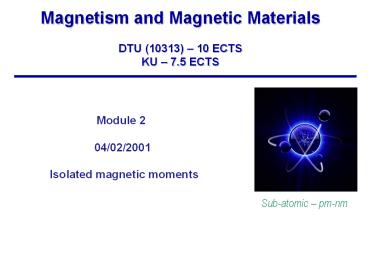Magnetism and Magnetic Materials - PowerPoint PPT Presentation
Title:
Magnetism and Magnetic Materials
Description:
Magnetism and Magnetic Materials DTU (10313) 10 ECTS KU 7.5 ECTS Module 2 04/02/2001 Isolated magnetic moments Sub-atomic pm-nm Flashback What have we ... – PowerPoint PPT presentation
Number of Views:402
Avg rating:3.0/5.0
Title: Magnetism and Magnetic Materials
1
Magnetism and Magnetic Materials DTU (10313)
10 ECTS KU 7.5 ECTS
Module 2 04/02/2001 Isolated magnetic moments
2
Flashback
What have we learned last time? You tell us
3
Intended Learning Outcomes (ILO)
(for todays module)
- Establish the link between g-factor and measured
angle in the EdH experiment - Verify that magnetism in Fe is mostly from spin
angular momentum - Describe what Diamagnetism is
- Estimate the diamagnetic response of He
- Describe what Paramagnetism is
- Explain why some atoms are diamagnetic and why
some are paramagnetic - List the three Hunds rules and apply them to a
few atoms
4
Einstein de Haas
Consider the following scenario A soft iron bar
magnet placed in a torsion balance, initially
demagnetized, saturates under the influence of
the magnetic field generated by a coil. The
angular momentum J associated with the acquired
moment MV sets the magnet in motion. A laser beam
is used to measure an equilibrium angle. Can you
measure the g-factor from this experiment, and
assess whether magnetism in Fe is from spin or
oam? Parameters R4 cm, H6 cm, k10-11
Nm r7874 kg/m3, MS1707 A/m
5
Hamiltonian of an atom in a magnetic field
The Hamiltonian of an atom in a magnetic field
has two main components the diamagnetic term,
and the paramagnetic term
Spin (for each electron)
OAM
Initial Hamiltonian of the atom
Hamiltonian in presence of a magnetic field
Explicit version of the Hamiltonian
Is the Hamiltonian gauge invariant?
6
Magnetic susceptibility
How strongly a material magnetizes in response to
an external field
Note -Difference between intrinsic and
experimental susceptibility (demag factor
involved) -Other definitions of
susceptibility --molar (cVm) --mass (c/r)
Focus on the initial magnetization
7
Diamagnetism
All atoms and ions (except perhaps H), have
nonzero diamagnetic responses to an external
field. It is, however, pretty small, and often
masked by the paramagnetic response of atoms with
a net moment (unpaired electrons)
Try this out with He. Does it match?
Theres another contribution Landau diamagnetism
(will be dealt with later)
8
Diamagnetic and paramagnetic susceptibilities
9
Paramagnetism semiclassical
If J is not zero, then you have paramagnetism
Total angular momentum
Energy of the moment at an angle
What is the expected averaged moment along the
field axis?
Langevin function
n is the volume density of moments
10
The J1/2 case
Several similarities
Two spins, J1/2, just two states (parallel or
AP), to average statistically
Estimate the paramagnetic susceptibility
11
Generic J and the Brillouin function
12
Lande g-value and effective moment
J1/2
J3/2
J5
Curie law cCC/T
13
Van Vleck paramagnetism
Another contribution to the paramagnetic
susceptibility (theres one moremobile electrons
Pauli)
If J0, in principle there is no paramagnetic
term. However, if we go second-order, and
consider the possibility of excited states
(off-diagonal matrix terms) with nonzero J, then
we have
Which is positive (para), and T-independent.
Why is it T-indepenent?? And why was the Langevin
term T-dependent instead?
John H. van Vleck, Nobel prize lecture
14
The multi-electron atom and the Hunds rules
With many electrons, it gets messy. How do
electrons choose which state to occupy?
- Arrange the electronic wave function so as to
maximize S. In this way, the Coulomb energy is
minimized because of the Pauli exclusion
principle, which prevents electrons with parallel
spins being in the same place, and this reduces
Coulomb repulsion. - The next step is to maximize L. This also
minimizes the energy and can be understood by
imagining that electrons in orbits rotating in
the same direction can avoid each other more
effectively. - Finally, the value of J is found using JL-S if
the shell is less than half-filled, and JLS is
the shell is more than half-filled. This third
rule arises from an attempt to minimize the
spin-orbit energy.
Find the electronic structure of Fe3, Ni2,
Nd3, Dy3, and determine their spin configuration
2S1LJ
15
Sneak peek
16
Wrapping up
- Einstein de Haas how to distinguish L and S
- Diamagnetism universal, temperature independent
- Paramagnetism J.neq.0, temperature dependent
- Curie law and implications
- Lande g-factor
- Hunds rules introduction
Next lecture Tuesday February 8, 1315, DTU
(?) Crystal fields (MB)

